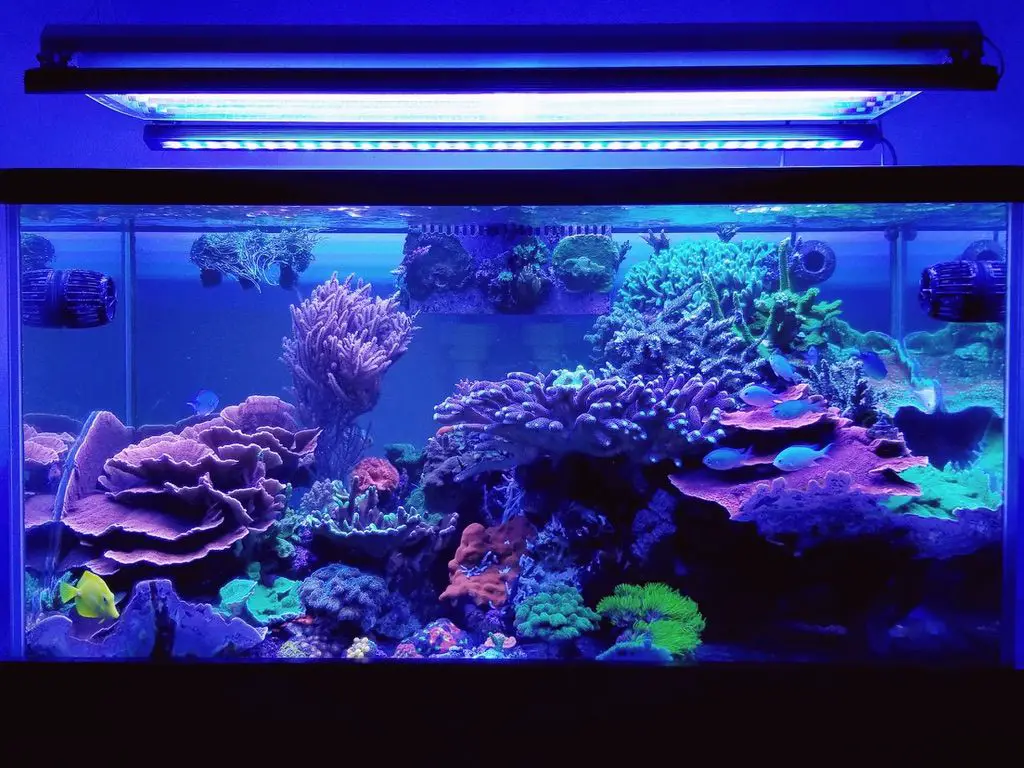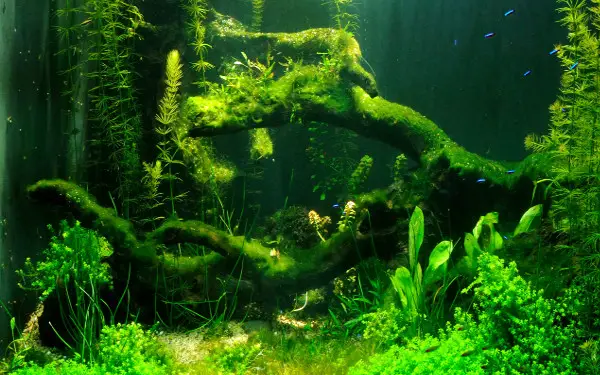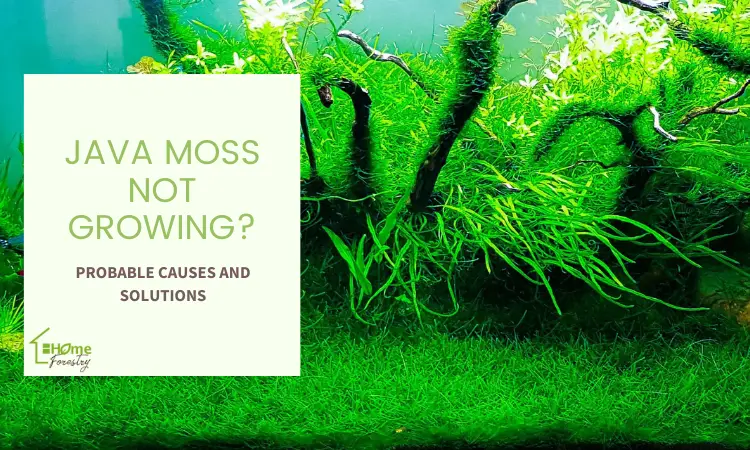If your Java moss isn’t growing, it can cause trouble in the aquarium. Fishes depend on it for food, shelter and it’ll ruin the appearance of the tank. So naturally, we understand your concern when your java moss won’t grow.
Therefore, today we will explore the concerns regarding Java moss not growing.
Java moss is a slow-growing plant compared to other plants. However, algae and malnutrition can further stall its growth. Moreover, factors like lighting, high temperature also affect its natural growth. With proper care by removing algae, adding fertilizers your java moss will thrive in no time.
However, if you have the time, we’d encourage you to read our article below. We’ve covered all the questions and doubts you may have regarding this.
Let’s begin this story!
Why Isn’t My Java Moss Growing?
Before getting started we would like to mention that, this section is for comparatively newbie aquarists. However, if you know the basics then jump onto the part where we explained how to speed up the growth of your java moss.
If not, then stay with us! We’ll try to help you in understanding everything about your java moss plants’ growth.
We can understand your worries when your java moss halts their growth. So in case, you’re wondering why is my Java moss not growing in my tank–
Since it grows slowly, it may seem that the moss isn’t growing. Additionally, sometimes it’s easy to overlook the very minute details in the tank. While this may not harm other organisms in your tank, it can slow down java moss growth.
So, let’s look at what can affect your java moss to halt its natural growth.
Factors Affecting Java Moss’ Growth
The factors here directly affect the growth rate of the plants. These include the lighting, amount nutrients, water temperature, and more. Let’s explore them one by one!
Lighting And Placement
Low lighting is one of the biggest growth factors of Java moss. You might be wondering- what happens to Java moss in no light?
Java moss requires low lighting to emulate its natural habitat. So, the light in your tank has to be adjusted that way. However, this problem can be solved by softening the light.

Now, let’s discuss the placement. Java moss needs mid to foreground placement. Higher placement means it’s exposed to more light, which is not ideal for them.
High Water Temperature
Java moss likes cooler waters to grow in. It’s tolerant of water temperatures from 15-30℃ or 59-86℉. However, for the best growth of java moss, you’ll need a range of 22-25℃ or 68-77℉.
The warmer the water, the tougher it gets for java moss to absorb nutrients. Consequently, your java moss won’t grow fast. So, it’s better to keep the water cold.
Improper Attachment
The java moss has unique sticky projections called rhizoids. These serve the purpose of fixing the moss on surfaces. So should you be concerned if java moss is not floating?
Since the java moss is a slow-growing plant, attachment is crucial. If your java moss isn’t attached to surfaces like driftwood, it won’t grow. This is because only after attachment, it can take in nutrients and grow.
If it can’t attach, then it will expend most of its energy drifting. This way it will be deprived of nutrient absorption that can lead to slower than usual growth.
Therefore, we recommend attaching your java moss to driftwood, bogwoods or rocks.
Troublesome Algae
Algae is present in most aquariums and tanks in small quantities. They act as food for some organisms and help replicate the natural environment for all the species.
However, algae tend to disturb java moss. Due to the stringy nature of the moss, it easily accumulates algae on the leaves.

When the algae smother the leaves, they’re unable to absorb nutrients from the water. This can then lead to malnutrition and even death.
Getting rid of the excess amount of algae is the only way to redemption from this.
Malnutrition
Now, keep in mind the Java moss growth rate–
Java moss has a slow-to-medium growth rate. It takes in nutrients slowly and then grows only by 1 to 1.5 inches each month.
The issue of malnutrition concerns the leaves. If the java moss can’t absorb nutrients from the water, it will suffer from malnutrition.
This can happen due to competition with algae and debris getting stuck on the leaves. With a lack of access to absorb food, the java moss starves. As it starves, its growth slows down and it becomes a big clumped mess.
The most common sign of malnutrition is when the java moss turns brown. As the leaves starve, they start to die out. This results in them turning brown as the leaves lose chlorophyll and can’t photosynthesize.
To tackle this issue you can apply liquid fertilizer to your tank. This will ensure the proper nourishment of your tank’s plants.
Well now that we’ve covered the signs, let’s proceed with the article. Let’s see how we can help java moss grow faster.
How To Grow Java Moss Fast?
Even though it’s a slow-growing plant, java moss can be helped to grow faster. Let’s explore them now, shall we?
To make java moss grow fast, clean the algae and modify the tank. It can be helped by attachment to driftwood, adjusting the tank for cold water, and soft light. You can also help it with the faster flow, regular trimming, and fertilization.
We’ve summarized the methods in the table below for your ease. Do take a look!
| Method | Required time for the method | Effectiveness | Budget needed |
| Clean the algae | 10 minutes | High | $10 |
| Attach moss to driftwood | 20 minutes for the entire process | High | $20-$30 depending on the driftwood |
| Cool the water | 1-2 hours, time is taken for water to freeze | Medium | $0 as you are freezing water at home |
| Soft light | Keep light off for 8 to 12 hours | Medium | $0 as you simply turn off the light |
| Increase water flow | 20 minutes to attach | Medium to high | $40 |
| Liquid fertilization | 10 to 15 minutes | High | $15 to $20 depending on the fertilizer |
| Trim brown parts | 10 to 15 minutes | High | $0 as you’re clipping using scissors |
With all that said, that was the basic overview on how to speed up the growth process. So, let’s get into it without any further ado!
Clean The Algae
Over and over again, we’ve mentioned that the biggest concern for java moss is algae. So, naturally, cleaning the algae will help it grow faster.
You can clean these 2 ways. How about we dive to explore them?
The Toothbrush Method
Here’s an interesting way you can get rid of java moss growing algae–
For this, you need to get a soft-bristled toothbrush. Every 3 days, take the java moss out and clean it with the toothbrush. Use a gentle sweeping motion to remove the algae from the leaves.
Once done, rinse the moss out and place it back in the tank. Your java moss should grow faster now.
The Peroxide Method
Hydrogen peroxide is readily available and suited to this task. More importantly, it’s safe to use in the tank.
The peroxide will kill the algae but not other organisms. For this method, you need to follow these simple steps-
- Firstly, you’ll need to drain your tank 25 % of the total volume.
- Next, add 2 tablespoons of peroxide to the water and leave it to soak for 1 hour.
- After that, you can simply fill the tank. This way the algae problem will be eradicated.
Now, how fast your java moss can grow will depend. However, if you plan to use this method, do so once every 2 weeks. Keep an eye on the java moss and see how it responds.
New leaves sprout within a month. That’ll be the sign that your java moss is now growing faster.
Attach The Java Moss To Driftwood, Bogwood, Nets, Or Rocks
By attaching the java moss to a surface, you ensure that it remains anchored. This way it can spend its energy to absorb nutrients from the water.
Now, time to know how to attach java moss on driftwood?
You can do this simply by following a few steps and with a few tools. For this task, you’ll need a rough surface like driftwood, bogwood, substrate, or rocks. You will also need some waterproof superglue, scissors, and tweezers.
Here are some probable products that you might want to add your moss to.
Here’s a step-by-step guide for you to stick the java moss to your desired surface.
- Firstly, take your surface of choice and use the scissors to score it. Make sure the surface has enough nooks for the rhizoids of the moss to attach and remain secured.
- Then take the java moss and cut a section with the scissors. Make sure to get a bushel that has at least 20 tendrils of leaves.
- After that, apply superglue to the surface in a thin and even layer. Use the tweezers to attach the section to the surface of choice.
- Lastly, place this between the base to the middle of the tank. You can then repeat this for the remaining moss.

You can also use the superglue method to attach the Java moss to some net. And then you can let this net float in the tank.
The crevices will serve as the surface and the rhizoids can easily attach themselves. Securing floating plants to one place also adds to the aesthetic of the tank. And let Java moss breathe.
This way, you make sure no moss drifts away. Once all of these grow, you should have uniform sections of healthy java moss within 2 months throughout the tank.
Keep The Water Cold
While Java moss is tolerant of water temperatures of up to 30℃, it grows best in cooler waters. The best temperature for Java moss is 20℃.
To help it grow faster, you need to cool your tank. You can do this in many ways. Each of these is simple and doesn’t require any additional equipment.
Firstly, keep the aquarium in a shady spot. Mainly, keep the tank away from direct sunlight. During the day, keep your tank light off. That’s more than enough light to keep all of your organisms healthy.
Secondly, you can freeze a couple of Ziploc bags full of water. Once frozen, gently place the bags on the surface of the water. This way, you can indirectly cool the water down fast.
If you’re using this method, do so every alternate day and use it with the first method. So, there’ll be no rapid changes in temperature and your tank organisms won’t be shocked. Consequently, no organism will be adversely affected.
Soften The Light
Your tank has a mix of diurnal and nocturnal species of plants and animals. So whatever light you have, make sure to turn it off for a few hours at a time. So let’s say your tank light runs on 48W.
So what to do with the tank lighting? You can keep the light off for 12 hours and on for the other 12. This way you limit the light and keep the algae in control. You aren’t starving or depriving the light-dependent organisms either.
If you’re confused about what light should you use in your tank, you check these lights.
| Image | Aquarium Lights | Buy from Amazon |
|---|---|---|
 | Hygger Full Spectrum Aquarium Light | Buy from Amazon |
 | NICREW ClassicLED Aquarium Light | Buy from Amazon |
 | VIPARSPECTRA Timer Control Aquarium Light | Buy from Amazon |
However, it’s better to utilize natural light, if you have that scope. Keep the windows open and let the light in and keep the tank light off during the aforementioned hours. The diffused light should help keep algae levels low.
Increase The Flow Of Water
Java moss is adjusted in waters that have low flow. This keeps nutrients in the water circulating, making it easy for them to absorb. A similar environment in the tank will help your java moss grow faster.
For this, you need a powerhead that regulates the flow. Once you set the powerhead make sure it turns the water 3 to 4 times hourly. So, if your tank is 30 gallons, the flow rate is between 100 to 120 gallons per hour.
If you’re unsure about which powerhead to get, take a look at our options below. These will help you get the flow just right.
| Image | Title | GPH Rating | Get from Amazon |
|---|---|---|---|
 | SunSun JVP Series | 530 to 800 GPH | Get from Amazon |
 | Uniclif Controllable Wavemaker | 1058 to 3400 GPH | Get from Amazon |
 | Jebao Cross Flow CP | 2700 to 3300 GPH | Get from Amazon |
The flow provided by the powerheads should help your java moss grow faster.
Add Liquid Fertilizer
Adding fertilizer is an easy way to improve java moss growth. If you want your java moss to grow fast, add some liquid fertilizer. And when you talk about liquid fertilizer, automatically a debate arises. Which is the best liquid fertilizer between Thrive and Easy Green.
This’ll dissolve and circulate around the water faster and help your java moss grow faster. However, do keep in mind that Java moss will also need the other tips mentioned in this section.
When those are combined with the fertilizer, there’ll be better absorption. This results in faster growth. Here are some of the most sought-after liquid fertilizers in the market.
| Image | Recommended Products | Grab it Now |
|---|---|---|
 | Seachem Flourish Freshwater Plant Supplement | Grab it Now |
 | MICROBE-LIFT All In One Aquatic Plant Fertilizer | Grab it Now |
 | Thrive All In One Aquatic Plant Fertilizer | Grab it Now |
Trim The Brown Parts
Trimming and pruning help with plant growth. This applies to Java moss too. If you notice brown patches grow among the green, take action then and there.
Take the moss out of the tank and wash it. Be gentle as you rinse it under a tap. Try to get out as much debris as possible.
After that, use scissors or tear off the brown patches you see. While doing so, be careful not to rip the green parts off. Once removed, rinse the java moss once more and then place it back in the tank.
Within 2 weeks, you should see pale green leaves emerge. This method of trimming should help with java moss growing stringy.
FAQs
Does Java moss need fertilizer?
Java moss does not need fertilizer. It can grow normally in any given tank conditions. However, if you want to speed up the process of growth, then yes you can use it. No harm will be done to the java moss.
Can Brown Java moss turn green again?
Yes indeed. Java moss can turn green again. Give the moss a thorough rinse to get rid of debris. Then, cut off the overly brown and dead fragments of the moss. Place it back in the tank. With the leaves open, java moss should turn green in a month.
Why is Java moss so expensive?
Java moss is expensive for demand and luck. This is a great moss to add as it acts as food for many types of small fish and shrimp. Some java moss despite slow growth can grow very large within 2 months. While others can take over 4 months to grow into a decent bushel.
Conclusion
Well, there you have it. Now you know all the reasons and remedies for java moss not growing. Keep an eye out on your tank and see if the moss and other companions are doing well.
We wish you luck with your java moss. Hope you find our advice useful. If you did find it useful, leave us a comment below.



